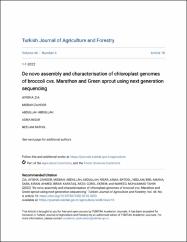| dc.contributor.author | Zia, Ayisha | |
| dc.contributor.author | Zahoor, Misbah | |
| dc.contributor.author | Abdullah, Abdullah | |
| dc.contributor.author | Nisar, Asma | |
| dc.contributor.author | Bibi, Amana | |
| dc.contributor.author | Saba, Kiran | |
| dc.contributor.author | Ahmed, Ibrar | |
| dc.contributor.author | Karataş, Arzu | |
| dc.contributor.author | Gürel, Ekrem | |
| dc.contributor.author | Waheed, Mohammad Tahir | |
| dc.date.accessioned | 2022-11-22T11:23:03Z | |
| dc.date.available | 2022-11-22T11:23:03Z | |
| dc.date.issued | 2022 | en_US |
| dc.identifier.citation | Zia A., Zahoor M., Abdullah A., Nisar A., Batool N., Bibi A., Saba K., Ahmed I., Karatas, A. & Waheed M. T. (2022). De novo assembly and characterisation of chloroplast genomes of broccoli cvs. Marathon and Green sprout using next generation sequencing. Turkish Journal of Agriculture and Forestry, 46(4), 525-535. https://doi.org/10.55730/1300-011X.3023 | en_US |
| dc.identifier.issn | 1300-011X | |
| dc.identifier.issn | 1303-6173 | |
| dc.identifier.uri | https://doi.org/10.55730/1300-011X.3023 | |
| dc.identifier.uri | https://hdl.handle.net/11436/7106 | |
| dc.description.abstract | The genus Brassica (family Brassicaceae) includes nutritionally and economically important species such as Brassica napus, Brassica rapa, and Brassica oleracea. Many varieties of B. oleracea are available in various morphological forms including nutritive vegetables such as cauliflower (var. botrytis), Brussels sprouts (var. gemmifera), kales and collards (var. acephala), kohlrabi (var. gongylodes), cabbage (var. capitata), and broccoli (var. italica). Objective of the present study was to sequence chloroplast genomes of two cultivars of broccoli: Marathon and Green sprout. The sequencing was done by next generation sequencing. The analysis was performed using Velvet, Geneious, GeSeq, tRNAscan-SE, ARAGORN, OrganellarGenomeDRAW, IRscope and REPuter. The genomes of both cultivars showed highly similar quadripartite structure of 153,365 bp. The LSC (83,136 bp) and SSC (17,835 bp) regions were separated by a pair of IR (26,197 bp) region. In total, 114 unique genes were present in both species, including 80 protein-coding, 30 tRNA and 4 rRNA genes, while 18 genes were duplicated in IRs. The highest amino acid encoding frequency was found for Leucine whereas cysteine was the least encoding amino acid. The codon usage analyses confirmed high encoding efficacy of codons that ended at 3'-end with A/T. Repeat analyses of these genomes revealed 415 microsatellites and 36 oligonucleotide repeats. Microsatellites motifs were mostly comprised of A/T instead of C/G. The comparative analyses confirmed the presence of 17 substitutions between both cultivars. Overall, this study will increase knowledge about the chloroplast genomes of broccoli and will provide a resource for chloroplast genetic engineering of this important edible plant. | en_US |
| dc.description.sponsorship | Higher Education Commission of Pakistan 7407/Federal/NRPU/RD/HEC/2017 | en_US |
| dc.language.iso | eng | en_US |
| dc.publisher | TUBİTAK Scientific & Technical Research Council Turkey | en_US |
| dc.rights | info:eu-repo/semantics/openAccess | en_US |
| dc.subject | Broccoli | en_US |
| dc.subject | Next generation sequencing | en_US |
| dc.subject | Chloroplast genome | en_US |
| dc.subject | Oligonucleotide repeats | en_US |
| dc.subject | Simple sequence repeats | en_US |
| dc.subject | Codon usage | en_US |
| dc.title | De novo assembly and characterisation of chloroplast genomes of broccoli cvs. Marathon and Green sprout using next generation sequencing | en_US |
| dc.type | article | en_US |
| dc.contributor.department | RTEÜ, Ziraat Fakültesi, Bahçe Bitkileri Bölümü | en_US |
| dc.contributor.institutionauthor | Karataş, Arzu | |
| dc.identifier.doi | 10.55730/1300-011X.3023 | en_US |
| dc.identifier.volume | 46 | en_US |
| dc.identifier.issue | 4 | en_US |
| dc.identifier.startpage | 525 | en_US |
| dc.identifier.endpage | 535 | en_US |
| dc.relation.journal | Turkish Journal of Agriculture and Forestry | en_US |
| dc.relation.publicationcategory | Makale - Uluslararası Hakemli Dergi - Kurum Öğretim Elemanı | en_US |


















